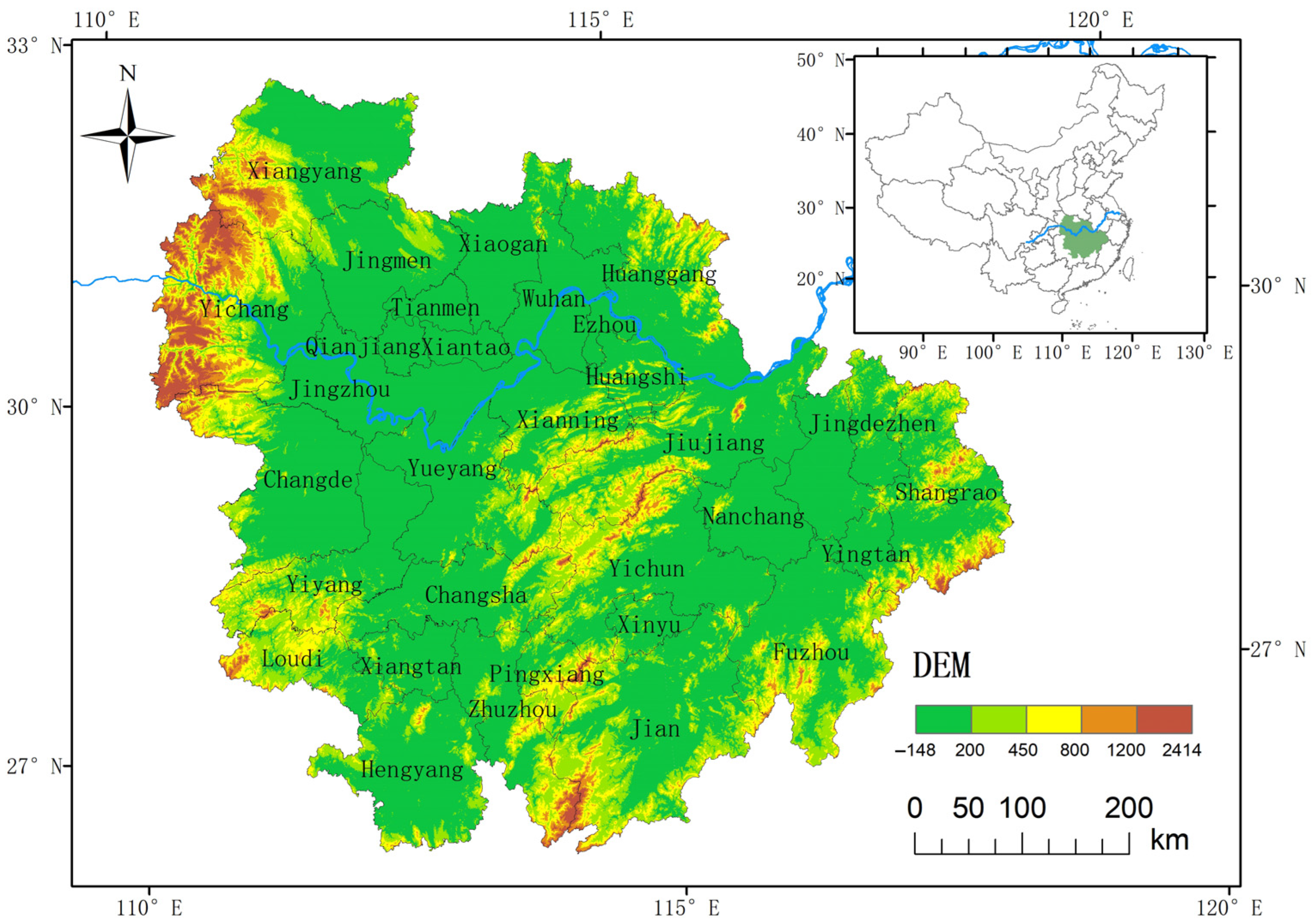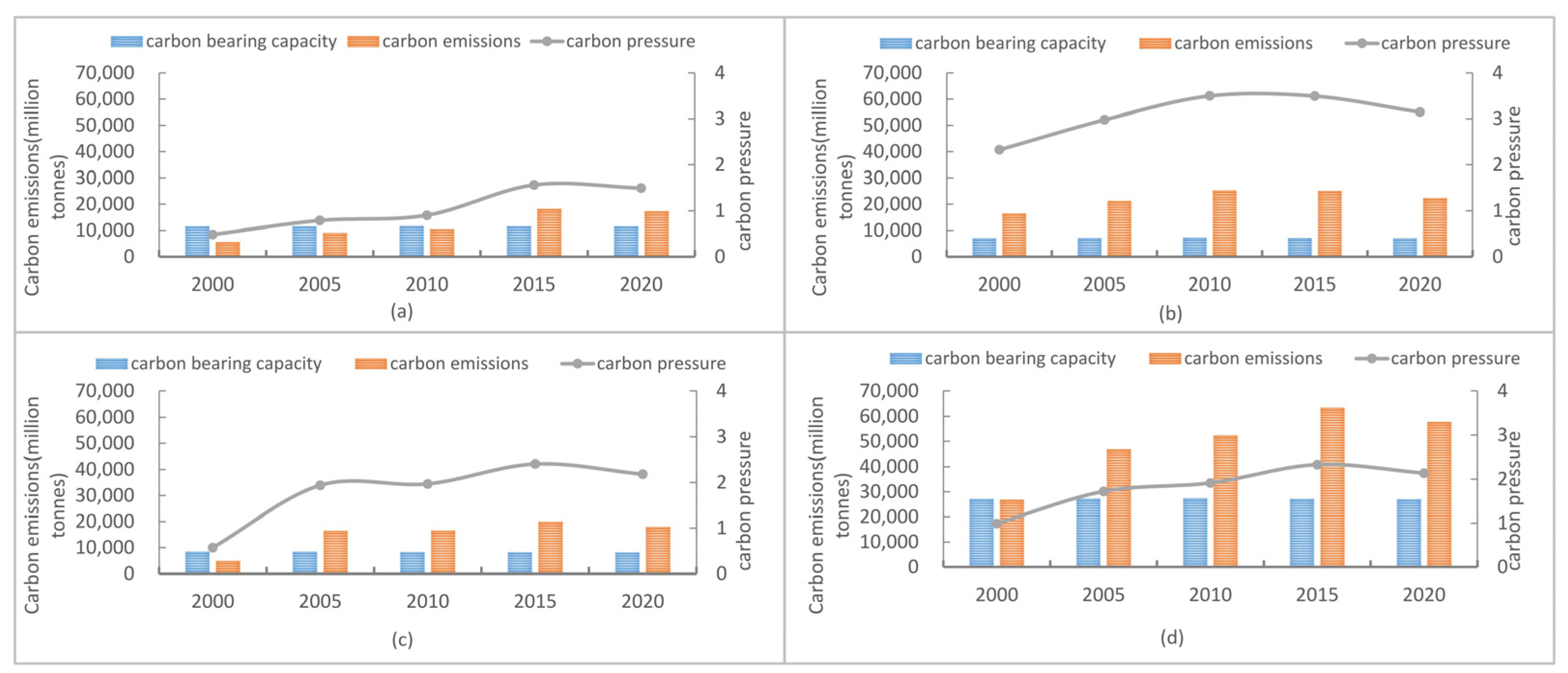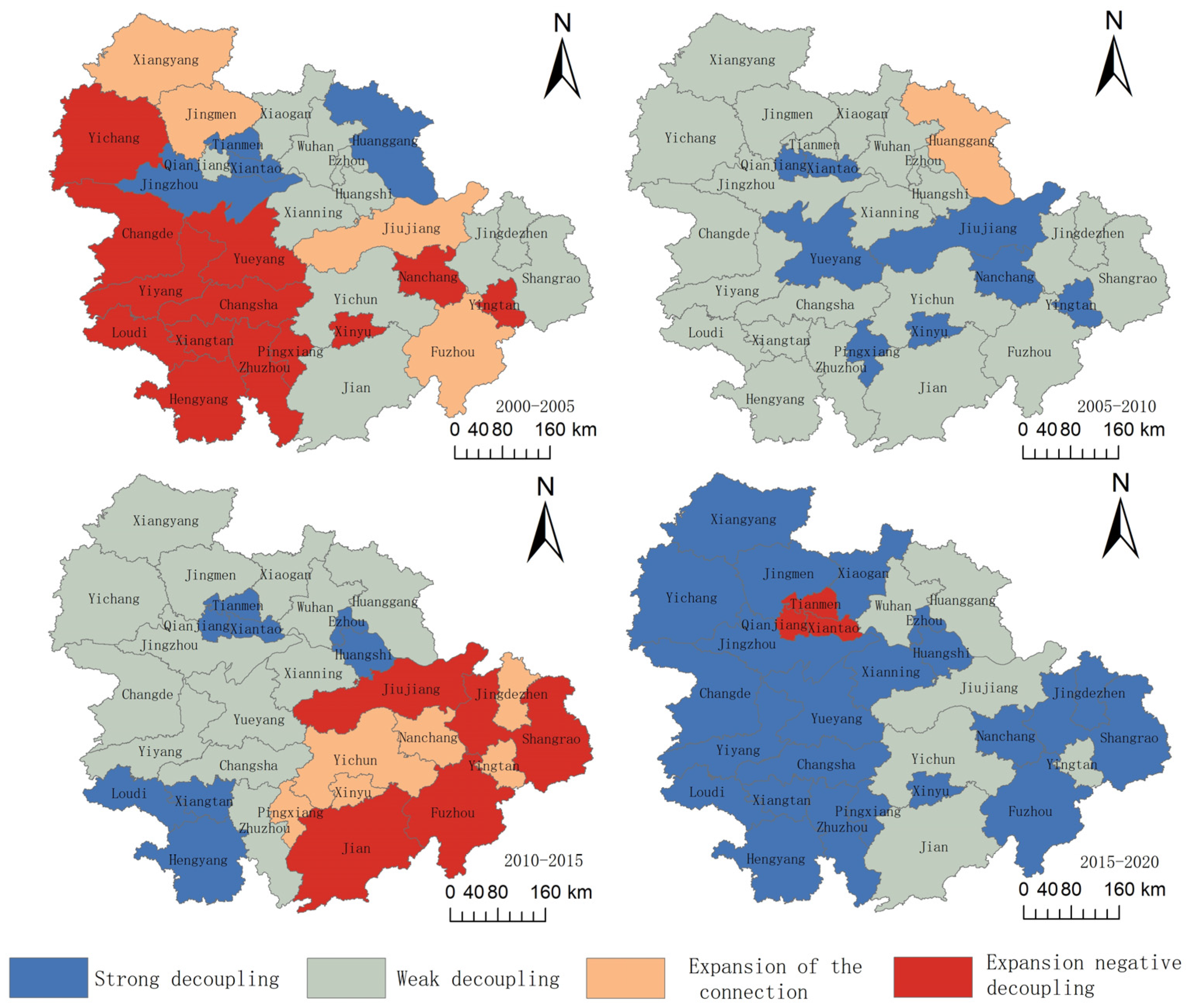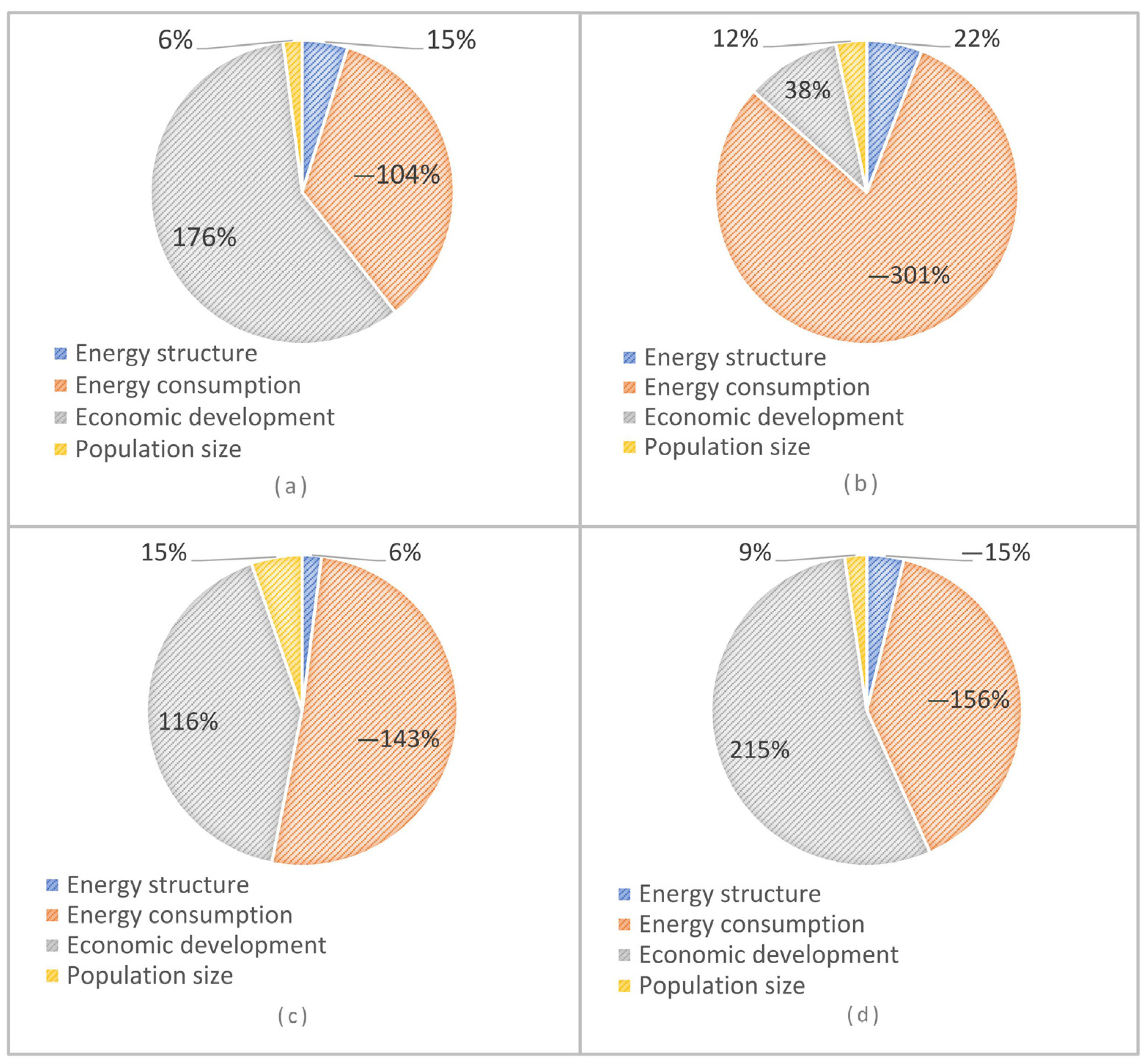Carbon Pressure and Economic Growth in the Urban Agglomeration in the Middle Reaches of the Yangtze River: A Study on Decoupling Effect and Driving Factors
Abstract
1. Introduction
2. Literature Review
3. Research Area
4. Research Methodology and Data Sources
4.1. Research Methodology and Data Sources
4.1.1. Carbon Pressure Measurement
- Urban carbon emission accounting
- 2.
- Urban carbon carrying capacity measurement
4.1.2. Tapio Decoupling Analysis
4.1.3. LMDI Index Decomposition Model
4.2. Data Sources
5. Analysis of Results
5.1. Spatial and Temporal Characteristics of Carbon Pressure of the Urban Agglomeration in the Middle Reaches of the Yangtze River
5.1.1. Analysis of Carbon Pressure Temporal Evolution of the Urban Agglomeration in the Middle Reaches of the Yangtze River
5.1.2. Analysis of the Spatial Evolution of Carbon Pressure of Urban Agglomeration in the Middle Reaches of the Yangtze River
5.2. Decoupling Effect of Carbon Pressure of Urban Agglomeration in the Middle Reaches of the Yangtze River
5.3. Carbon Pressure Drivers and Decomposition for Urban Agglomeration in the Middle Reaches of the Yangtze River
6. Conclusions and Suggestions
6.1. Research Conclusions
6.2. Policy Suggestion
6.3. Limitation
Author Contributions
Funding
Institutional Review Board Statement
Informed Consent Statement
Data Availability Statement
Conflicts of Interest
References
- Jiang, J.; Ye, B.; Xie, D.; Tang, J. Provincial-level carbon emission drivers and emission reduction strategies in China: Combining multi-layer LMDI decomposition with hierarchical clustering. J. Clean. Prod. 2017, 169, 178–190. [Google Scholar] [CrossRef]
- Liu, B.B.; Zuo, Q.T.; Diao, Y.X. The value and pathways of green technology innovation for ecological conservation and high-quality development of the Yellow River Basin. Resour. Sci. 2021, 43, 423–432. [Google Scholar] [CrossRef]
- Xu, G.; Dong, H.; Xu, Z.; Bhattarai, N. China can reach carbon neutrality before 2050 by improving economic development quality. Energy 2022, 243, 123087. [Google Scholar] [CrossRef]
- Davidson, M.; Karplus, V.J.; Zhang, D.; Zhang, X. Policies and institutions to support carbon neutrality in China by 2060. Econ. Energy Environ. Policy 2021, 10, 7–24. [Google Scholar] [CrossRef]
- Wang, C.; Shi, Y.; Zhang, L.; Zhao, X.; Chen, H. The policy effects and influence mechanism of China’s carbon emissions trading scheme. Air Qual. Atmos. Health 2021, 14, 2101–2114. [Google Scholar] [CrossRef]
- Li, Y.; Lan, S.; Ryberg, M.; Pérez-Ramírez, J.; Wang, X. A quantitative roadmap for China towards carbon neutrality in 2060 using methanol and ammonia as energy carriers. Iscience 2021, 24, 102513. [Google Scholar] [CrossRef]
- Zhang, R.; Hanaoka, T. Deployment of electric vehicles in China to meet the carbon neutral target by 2060: Provincial disparities in energy systems, CO2 emissions, and cost effectiveness. Resour. Conserv. Recycl. 2021, 170, 105622. [Google Scholar] [CrossRef]
- Weng, Y.; Cai, W.; Wang, C. Evaluating the use of BECCS and afforestation under China’s carbon-neutral target for 2060. Appl. Energy 2021, 299, 117263. [Google Scholar] [CrossRef]
- Liang, Z.; Xu, B. The spatial distribution of the migration of carbon pressure gravity center of provinces in China. Econ. Geogr. 2017, 37, 179–186. [Google Scholar]
- Xie, W.; Hu, S.; Li, F.; Cao, X.; Tang, Z. Carbon and water footprints of Tibet: Spatial pattern and trend analysis. Sustainability 2020, 12, 3294. [Google Scholar] [CrossRef]
- Peri, P.L.; Rosas, Y.M.; Ladd, B.; Díaz-Delgado, R.; Martinez Pastur, G. Carbon footprint of lamb and wool production at farm gate and the regional scale in Southern Patagonia. Sustainability 2020, 12, 3077. [Google Scholar] [CrossRef]
- Liu, Z.H.; Zhang, W.M.; Xiao, Z.Y.; Sun, J.B.; Li, D.D. Research on extended carbon emissions accounting method and its application in sustainable manufacturing. Procedia. Manuf. 2020, 43, 175–182. [Google Scholar] [CrossRef]
- Mahmoudian, F.; Lu, J.; Yu, D.; Nazari, J.A.; Herremans, I.M. Inter-and intra-organizational stakeholder arrangements in carbon management accounting. Br. Account. Rev. 2021, 53, 100933. [Google Scholar] [CrossRef]
- Zhang, Q.; Zheng, D.; Xu, X.S. Factor decomposition analysis on the energy carbon footprint ecological pressure change in China. J. Arid. Land Resour. Environ. 2015, 29, 41–46. [Google Scholar]
- Zhu, X.M.; Wang, Z.S. Study on the spatial correlation pattern of carbon footprint breadth and influencing factors in China. World Surv. Res. 2021, 332, 38–48. [Google Scholar]
- Bai, W.R.; Wang, Z.; LV, J. Summary and analysis of international standards on carbon footprint accounting. Acta Ecol. Sin. 2014, 34, 7486–7493. [Google Scholar]
- Yan, F.; Wang, Y.; Du, Z.; Chen, Y.; Chen, Y. Quantification of ecological compensation in Beijing-Tianjin-Hebei based on carbon footprint calculated using emission factor method proposed by IPCC. Trans. Chin. Soc. Agric. Eng. 2018, 34, 15–20. [Google Scholar]
- Mi, Z.; Wei, Y.M.; Wang, B.; Meng, J.; Liu, Z.; Shan, Y.; Liu, J.; Guan, D. Socioeconomic impact assessment of China’s CO2 emissions peak prior to 2030. J. Clean. Prod. 2017, 142, 2227–2236. [Google Scholar] [CrossRef]
- Chen, J.; Li, Z.; Dong, Y.; Song, M.; Shahbaz, M.; Xie, Q. Coupling coordination between carbon emissions and the eco-environment in China. J. Clean. Prod. 2020, 276, 123848. [Google Scholar] [CrossRef]
- IEA. World Energy Outlook 2012. Paris: International Energy Agency (IEA). 2012. Available online: https://www.iea.org/reports/world-energy-outlook-2012 (accessed on 11 January 2023).
- Shan, Y.; Guan, D.; Liu, J.; Mi, Z.; Liu, Z.; Liu, J.; Schroeder, H.; Cai, B.; Chen, Y.; Shao, S.; et al. Methodology and applications of city level CO2 emission accounts in China. J. Clean. Prod. 2017, 161, 1215–1225. [Google Scholar] [CrossRef]
- Ghosh, T.; Elvidge, C.D.; Sutton, P.C.; Baugh, K.E.; Ziskin, D.; Tuttle, B.T. Creating a global grid of distributed fossil fuel CO2 emissions from nighttime satellite imagery. Energies 2010, 3, 1895–1913. [Google Scholar] [CrossRef]
- Zhao, J.; Ji, G.; Yue, Y.; Lai, Z.; Chen, Y.; Yang, D.; Yang, X.; Wang, Z. Spatio-temporal dynamics of urban residential CO2 emissions and their driving forces in China using the integrated two nighttime light datasets. Appl. Energy 2019, 235, 612–624. [Google Scholar] [CrossRef]
- Liu, M.D.; Meng, J.J.; Liu, B.H. Progress in the studies of carbon emission estimation. Trop. Geogr. 2014, 34, 248–258. [Google Scholar]
- Churkina, G.; Brown, D.G.; Keoleian, G. Carbon stored in human settlements: The conterminous United States. Glob. Chang. Biol. 2010, 16, 135–143. [Google Scholar] [CrossRef]
- Pickett, S.T.; Cadenasso, M.L.; Grove, J.M.; Boone, C.G.; Groffman, P.M.; Irwin, E.; Kaushal, S.S.; Marshall, V.; McGrath, B.P.; Nilon, C.H.; et al. Urban ecological systems: Scientific foundations and a decade of progress. J. Environ. Manag. 2011, 92, 331–362. [Google Scholar] [CrossRef]
- Liu, H.Q.; Tan, L.F.; Yang, H.J. Research on Carbon Emission Control of High-Energy-Consuming Industries in Yunnan Province from the Perspective of Contribution and Sensitivity. Ecol. Econ. 2020, 36, 41–47. [Google Scholar]
- Tapio, P. Towards a theory of decoupling: Degrees of decoupling in the EU and the case of road traffic in Finland between 1970 and 2001. Transp. Policy 2005, 12, 137–151. [Google Scholar] [CrossRef]
- Kang, J.; Zhao, T.; Ren, X.; Lin, T. Using decomposition analysis to evaluate the performance of China’s 30 provinces in CO2 emission reductions over 2005–2009. Nat. Hazards 2012, 64, 999–1013. [Google Scholar] [CrossRef]
- Engo, J. Decomposition of Cameroon’s CO2 emissions from 2007 to 2014: An extended Kaya identity. Environ. Sci. Pollut. Res. 2019, 26, 16695–16707. [Google Scholar] [CrossRef]
- Peters, G.P.; Weber, C.L.; Guan, D.; Hubacek, K. China’s growing CO2 emissions a race between increasing consumption and efficiency gains. Environ. Sci. Technol. 2007, 41, 5939–5944. [Google Scholar] [CrossRef]
- Xu, Y.; Dietzenbacher, E. A structural decomposition analysis of the emissions embodied in trade. Ecol. Econ. 2014, 101, 10–20. [Google Scholar] [CrossRef]
- Guo, S.; Diao, Y. Spatial-temporal evolution and driving factors of coupling between urban spatial functional division and green economic development: Evidence from the Yangtze River Economic Belt. Front. Environ. Sci. 2022, 10, 2312. [Google Scholar] [CrossRef]
- Song, M.; Chang, L.Y.; Hao, X.G. Analysis on the Spatio-Temporal Evolution and Driving Factors of Carbon Pressure of the Urban agglomeration in the Middle Reaches of the Yangtze River. J. Environ. Econ. 2022, 6, 23–40. [Google Scholar]
- Jing, Q.; Hou, H.; Bai, H.; Xu, H. A top-bottom estimation method for city-level energy-related CO2 emissions. China Environ. Sci. 2019, 39, 420–427. [Google Scholar]
- Fang, J.; Guo, Z.; Piao, S.; Chen, A. Terrestrial vegetation carbon sinks in China, 1981–2000. Sci. China Ser. D Earth Sci. 2007, 50, 1341–1350. [Google Scholar] [CrossRef]
- Zhang, H.; Peng, Q.; Wang, R.; Qiang, W.; Zhang, J. Spatiotemporal patterns and factors influencing county carbon sinks in China. Acta Ecol. Sin. 2020, 40, 8988–8998. [Google Scholar]
- Fang, J.; Yu, G.; Liu, L.; Hu, S.; Chapin III, F.S. Climate change, human impacts, and carbon sequestration in China. Proc. Natl. Acad. Sci. USA 2018, 115, 4015–4020. [Google Scholar] [CrossRef]
- Tang, X.; Zhao, X.; Bai, Y.; Tang, Z.; Wang, W.; Zhao, Y.; Wan, H.; Xie, Z.; Shi, X.; Wu, B.; et al. Carbon pools in China’s terrestrial ecosystems: New estimates based on an intensive field survey. Proc. Natl. Acad. Sci. USA 2018, 115, 4021–4026. [Google Scholar] [CrossRef]
- Piao, S.; Fang, J.; Zhou, L.; Zhu, B.; Tan, K.; Tao, S. Changes in vegetation net primary productivity from 1982 to 1999 in China. Glob. Biogeochem. Cycles 2005, 19, 8988–8998. [Google Scholar] [CrossRef]
- Kong, D.S.; Zhang, H. Economic value of wetland ecosystem services in the Heihe National Nature Reserve of Zhangye. Acta Ecol. Sin. 2015, 35, 972–983. [Google Scholar]
- Lai, L.; Huang, X.J.; Liu, W.L. Adjustment for regional ecological footprint based on input-output technique: A case study of Jiangsu Province in 2002. Acta Ecol. Sin. 2006, 26, 1285–1292. [Google Scholar]
- Wang, M.; Feng, X.Z.; An, Q.; Zhuo, Y.; Zhao, M.X.; Du, X.L.; Wang, P. Study on green and low-carbon development in Qinghai Province Based on decoupling index and LMDI. Adv. Clim. Chang. Res. 2021, 17, 598. [Google Scholar]






| Land Use Type | Carbon Sink Factor | Reference Sources | |
|---|---|---|---|
| Woodland | With woodland | Fang et al. [38], Tang et al. [39] | |
| Shrubland | |||
| Open woodland | |||
| Other woodland | |||
| Grassland | High cover grassland | Piao et al. [40], Fang et al. [36] | |
| Medium cover grassland | |||
| Low-cover grassland | |||
| Water area | River and canal | Kong et al. [41] | |
| Lakes | |||
| Reservoir ponds | |||
| Mudflats | |||
| Beachland | |||
| Unused land | Unused land | Li et al. [42] | |
| Decoupling Type | Decoupling Status | e | ||
|---|---|---|---|---|
| Connections | Expansion Connection | + | + | [0.8, 1.2) |
| Recession Connection | − | − | [0.8, 1.2) | |
| Decoupling | Strong decoupling | − | + | (−∞, 0) |
| Weak decoupling | + | + | [0, 0.8) | |
| Negative decoupling | Recession decoupling | − | − | [1.2, +∞) |
| Strong negative decoupling | + | − | (−∞, 0) | |
| Weak negative decoupling | − | + | [0, 0.8) | |
| Expansion negative decoupling | + | + | [1.2, +∞) |
| Year | Urban Ag-Glomeration | Carbon Pressure Change Rate | GDP Change Rate | Decoupling Index | Decoupling Type |
|---|---|---|---|---|---|
| 2000–2005 | Urban agglomeration encircling Poyang Lake | 0.6274 | 1.1750 | 0.5339 | Weak decoupling |
| Wuhan urban agglomeration | 0.2813 | 0.5307 | 0.5301 | Weak decoupling | |
| Urban agglomeration around Changsha-Zhuzhou-Xiangtan | 2.3847 | 0.8744 | 2.7272 | Expansion negative decoupling | |
| Urban agglomeration in the middle reaches of the Yangtze River | 0.7352 | 0.7701 | 0.9547 | Expansion Connection | |
| 2005–2010 | Urban agglomeration encircling Poyang Lake | 0.1459 | 1.3855 | 0.1053 | Weak decoupling |
| Wuhan urban agglomeration | 0.1738 | 1.4268 | 0.1218 | Weak decoupling | |
| Urban agglomeration around Changsha-Zhuzhou-Xiangtan | 0.0157 | 1.5752 | 0.0099 | Weak decoupling | |
| Urban agglomeration in the middle reaches of the Yangtze River | 0.1120 | 1.4675 | 0.0763 | Weak decoupling | |
| 2010–2015 | Urban agglomeration encircling Poyang Lake | 0.7336 | 0.7900 | 0.9285 | Expansion Connection |
| Wuhan urban agglomeration | −0.0007 | 0.9789 | −0.0007 | Strong decoupling | |
| Urban agglomeration around Changsha-Zhuzhou-Xiangtan | 0.2225 | 0.8625 | 0.2579 | Weak decoupling | |
| Urban agglomeration in the middle reaches of the Yangtze River | 0.2187 | 0.8926 | 0.2450 | Weak decoupling | |
| 2015–2020 | Urban agglomeration encircling Poyang Lake | −0.0447 | 0.4817 | −0.0928 | Strong decoupling |
| Wuhan urban agglomeration | −0.0997 | 0.3980 | −0.2506 | Strong decoupling | |
| Urban agglomeration around Changsha-Zhuzhou-Xiangtan | −0.0931 | 0.3845 | −0.2421 | Strong decoupling | |
| Urban agglomeration in the middle reaches of the Yangtze River | −0.0829 | 0.4120 | −0.2012 | Strong decoupling |
Disclaimer/Publisher’s Note: The statements, opinions and data contained in all publications are solely those of the individual author(s) and contributor(s) and not of MDPI and/or the editor(s). MDPI and/or the editor(s) disclaim responsibility for any injury to people or property resulting from any ideas, methods, instructions or products referred to in the content. |
© 2023 by the authors. Licensee MDPI, Basel, Switzerland. This article is an open access article distributed under the terms and conditions of the Creative Commons Attribution (CC BY) license (https://creativecommons.org/licenses/by/4.0/).
Share and Cite
Ding, H.; Wang, Z.; Huang, C.; Liu, L.; Bedra, K.B. Carbon Pressure and Economic Growth in the Urban Agglomeration in the Middle Reaches of the Yangtze River: A Study on Decoupling Effect and Driving Factors. Sustainability 2023, 15, 7862. https://doi.org/10.3390/su15107862
Ding H, Wang Z, Huang C, Liu L, Bedra KB. Carbon Pressure and Economic Growth in the Urban Agglomeration in the Middle Reaches of the Yangtze River: A Study on Decoupling Effect and Driving Factors. Sustainability. 2023; 15(10):7862. https://doi.org/10.3390/su15107862
Chicago/Turabian StyleDing, Hanqi, Zhiyuan Wang, Chunhua Huang, Luyun Liu, and Komi Bernard Bedra. 2023. "Carbon Pressure and Economic Growth in the Urban Agglomeration in the Middle Reaches of the Yangtze River: A Study on Decoupling Effect and Driving Factors" Sustainability 15, no. 10: 7862. https://doi.org/10.3390/su15107862
APA StyleDing, H., Wang, Z., Huang, C., Liu, L., & Bedra, K. B. (2023). Carbon Pressure and Economic Growth in the Urban Agglomeration in the Middle Reaches of the Yangtze River: A Study on Decoupling Effect and Driving Factors. Sustainability, 15(10), 7862. https://doi.org/10.3390/su15107862






